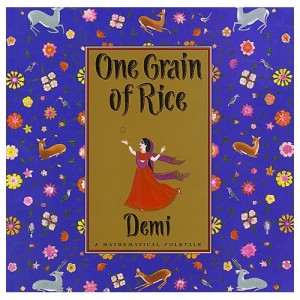 by Demi
by Demi
Rani, a clever girl, outsmarts a very selfish raja and saves her village. When offered a reward for a good deed, she asks only for one grain of rice, doubled each day for 30 days. Remember your math? That’s lots of rice: enough to feed a village for a good.
Strategies/Skills Used
Reading Strategy 1: Access background knowledge.
Reading Strategy 2: Predict what will be learned or what will happen.
Reading Strategy 6: Connect what you read with what you already know.
Reading Strategy 7: Determine the most important ideas and events and the relationship between them.
Reading Strategy 8: Extract information from text, charts, graphs, maps and illustrations.
Reading Strategy 11: Make inferences and draw conclusions.
Reading Strategy 12: Reflect and respond.
Writing Skill 2: I organize my ideas based on my purpose for writing.
Writing Skill 4: I write so my thoughts flow smoothly and are easy to read.
 TEACHING THE ACTIVITY: PRE-READING
TEACHING THE ACTIVITY: PRE-READING
(1) Remind students that good readers blend information that they read with their prior knowledge or experiences.
(2) List the following statements so all students can see them:
- All leaders are wise and fair.
- It is unfair to have to share with those who are less fortunate.
- If you find something that is lost, you must return it to the owner.
- You should only take as much as you need.
(3) Present the above statements to students before you read the text. Next, have students discuss each statement and agree or disagree with it.
(4) Encourage students to predict what the story might be about based on the statements. See Anticipation Guide.
 TEACHING THE ACTIVITY: DURING READING
TEACHING THE ACTIVITY: DURING READING
(5) Choose a problem or conflict from the text, e.g. Character vs Character, Character vs Self, Character vs Nature, or Character vs Society. Have students decide what events are related to this conflict as well as the reasons for the event and the effect that it had. See Thinking While Reading.
 TEACHING THE ACTIVITY: POST-READING
TEACHING THE ACTIVITY: POST-READING
(6) Act out a courtroom scene involving the characters from the story. Address the conflict created by the raja when he stored all the rice and would not share it when there was a famine. See Judge and Jury.
(7) Highlight the circular nature of One Grain of Rice which began and ended with a raja who believed he was wise and fair. Encourage students to write their own circular story that begins and ends in the same place. See Circular Stories.